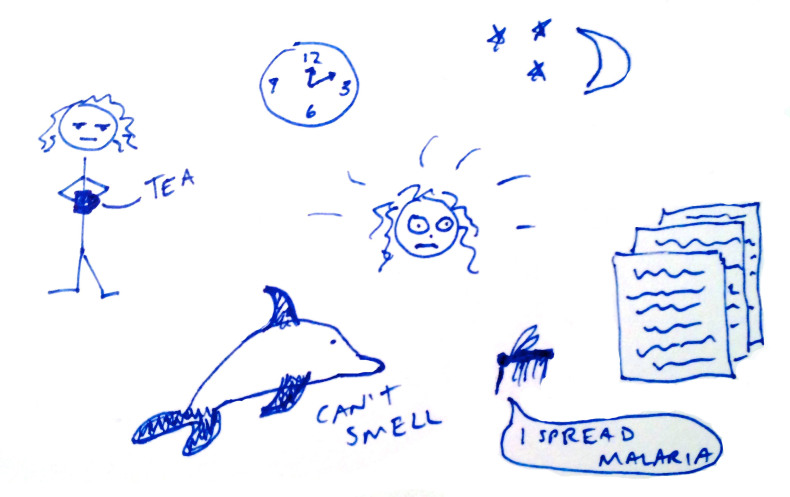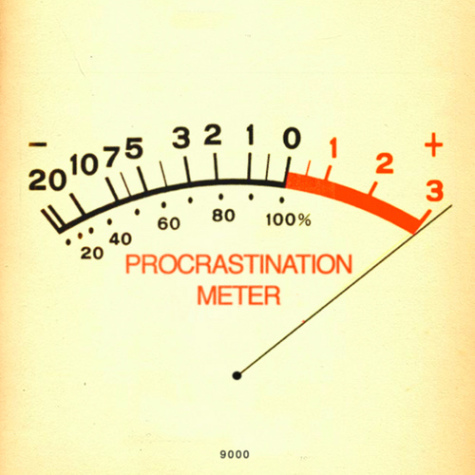 1. Write late at night, preferably the night before your deadline. That’s when the creative juices will really be churning. Your gut will be churning too. With panic.
1. Write late at night, preferably the night before your deadline. That’s when the creative juices will really be churning. Your gut will be churning too. With panic.
2. Don’t write the whole piece in one fell swoop. Focus on a single sentence. Make sure that sentence is perfect before you move on to the next. Never mind that the entire paragraph may eventually be trashed. This. Sentence. Must. Be. Perfect. Agonize over it. Erase it. Try again. Get frustrated. Check Facebook. Maybe one of your writer friends has posted something on her newsfeed that will help you crack this goddamned sentence. Nope. No helpful hints. But here’s a video of a bunny chasing a cat. Adorable! Maybe you’d like to own a bunny. Research how to litter box train a rabbit.
3. Now it’s 1am. Time to really get serious. Go downstairs and make a cup of tea. Choose Tazo Focus tea for obvious reasons. Discover that the tea’s name is nothing but an empty promise.
4. To write this article, you’ll need to understand how malaria is transmitted. Malaria parasites are complex creatures. There is a lot to know. Google  “malaria life cycle.” End up reading a study from 1955 about what happens when you vaccinate New Hampshire red chickens with dead avian malaria parasites. Realize you have no idea how you got there.
“malaria life cycle.” End up reading a study from 1955 about what happens when you vaccinate New Hampshire red chickens with dead avian malaria parasites. Realize you have no idea how you got there.
5. Set a timer. Tell yourself that you must complete the lede in the next 25 minutes. Fail.
6. Begin to question your life choices. Examine every bad decision that led you to be sitting in front of a nearly blank screen at 3am with your gut churning. If only you’d followed your dream to become a marine biologist! You’d be playing with dolphins right now, not writing this godawful feature! You’d be married to some bronzed boat captain. There would be no deadlines. Only love and the sweet smell of the ocean.
7. Realize you don’t know whether dolphins can smell. Decide you MUST KNOW IMMEDIATELY. Even though you aren’t writing about dolphins. (Answer: They probably can’t. They don’t have olfactory nerves).
8. Go to the kitchen. Eat all the things. Put Nutella on a gummy bear. No one is awake to judge you.
9. Take a bathroom break. Notice that someone has (once again!) left a smear of toothpaste in the sink. Clean the sink. And the mirror. And the bathtub.
10. Write as if your life depended on it. See that you have a full page of words, some of them about malaria. Congratulate yourself with a handful of salami.
11. Sleep for 3.75 hours. Wake up. Write some more. Wonder what a deadline of December 16th means. 8am? 5pm? Or perhaps anytime before midnight? Midnight your time or your editor’s? So many questions!
12. Make a pot of coffee. Grind the beans by hand.
13. Noon already?! Time to swap your pajama pants for sweat pants and put on a bra. All the best writers wear bras.
14. Realize that you now know TOO much about malaria. How could you possibly write just 2,500 words!? You’ll need 5,000 at least, and another two weeks. Despair. Repeat step #6.
15. Try to print out your draft. But the &%$@ing printer isn’t working! Spend 45 minutes sifting through Epson support threads. Fix the printer. Bask in the short-lived sense of accomplishment that comes with successfully completing a task.
16. Print a draft of the article. Make dramatic slashes and illegible notes to yourself. Draw arrows everywhere.
17. Decide to go for a walk. Some people do their best thinking when they’re walking. Rethink the entire structure.
18. Revise. Despair. Revise.
19. Read draft one last time to check for typos. Realize that this story is so much worse than you meant it to be. Feel sad. Consider becoming a doctor. Email article to your editor. Feel immensely relieved. Skip and dance about.
20. Pour yourself a glass of wine. You deserve it!
Extra credit reading:
Why Procrastinators Procrastinate
This Is Why I’ll Never Be an Adult
Image credit: Emilie Ogez via Flickr
Brb, buying a bra. This will take a least a good couple of hours.
This hits so close to home, my palms are sweating just reading it. No wait. That’s salami grease! Nevermind.
Think about next paragraph. Get bored, realize if the writer’s bored, the paragraph must be boring. Leg goes into cramp. Lie down and wiggle leg. Pain doesn’t go away but becomes less novel, wonder if leg cramp is more or less painful than next paragraph. Look at previous paragraph. Decide to comment on Cassie’s post.
Relate so strongly to post, spend half an hour distributing it around social media (after agonizing how to most cleverly preface it) instead of working on own feature. Realize there is nowhere else to share this article. Feel empty inside. Go back to writing article about migrating birds. Why did I chose this topic? Remember I need to make a Christmas TODO list….
“All the best writers wear bras.” There. You’ve settled it.
Darn. All this time I’ve been wearing camisoles. Why didn’t anyone tell me this before?!
I knew I was doing something wrong. BRB going to buy Tazo Focus tea.
I really love you for writing this, Cassandra Willyard. I really do. It made me happier than the bunny chasing a cat video and the rappelling Australian cattle dog video and the Tom Hiddleston and Rodney Crowell video combined. I know this because I watched them all today. Why not? My deadline isn’t until tomorrow.
Thanks – Such a good laugh from this. I feel so much more *normal* now 🙂 Except when I quit the day job I swore to never wearing bras anymore unless going out in public… might ought to rethink that stand…
One more idea — check your email while re-re-re-rewriting one of the thousands of para’s. in your book…this particular one about the meaning of 16S rRNA (you know, the really big important meaning you don’t want to eff up) …and you spot “how to write a science feature” GOLDMINE!! This will save me!! And. here. I. am.
You have captured many elements of my writing life perfectly. Thanks for a good laugh.
Thanks for the links too, nothing like reading an article on how to avoid procrastination when I should be working.
You made laugh out loud! Mind you, I am writing at an undisclosed location whose name ends in “-bucks”. Thanks for a great post, you nailed it, yet somehow I am picturing Asimov and Sagan wearing a bra…(:-)
This is precisely accurate except that you left out 1) while pulling out the bra, realize how much your closet needs cleaning, and resolve to do just a little of it RIGHT AT THAT MOMENT; and 2) chastising yourself for having gone so many months without writing to your aunt in Massachussetts, a problem that can be so readily fixed just also right at that moment.
You have comrades everywhere!
Excellent! But I miss one: fight with the reference manager and the bibliography and citation style
Somehow reading this felt very therapeutic. Thanks Cassandra!
How to Edit a Science Feature:
1. Check inbox.
2. Discover that draft feature is not there because writer has spectacularly blown deadline while following steps #1-18 above.
3. Wait. Pour yourself (another) glass of wine. Adjust bra.
4. Wait some more. Hope that this one, if it does ever turn up, will be so beautifully written that it can be waved through to production with zero work from you.
5. Start worrying. Revise next 3 months’ schedule in case feature doesn’t ever emerge and you need to fill hole in magazine with another story.
6. Check inbox. It’s arrived!
7. Bit late to start editing it now though. You can do it tomorrow.
This is the only way! There’s a loophole between #11 and #12 though, for next time. If you assume a midnight deadline, you instantly gain another 8 hours of writing time b/c who checks their email at midnight (other than science feature writers)?
I am going to share this with my Writing about Health and Medicine students next semester!
I’m reading this essay instead of writing a piece that’s due soon. Excellent distraction! Thank you! (And very funny. Loved it.)
Oh, and I really should mention that this week I cleaned out my underwear drawer and, a day later, the pantry (we had those little moths). The latter of course included extensive research on the best containers for keeping bugs out of cereal followed by extensive research on where to buy said containers. All instead of writing. You can bet when those containers arrive I’ll be a very busy bee…not writing.
I think to write a science feature one needs full grasp of the topic. Then, only you can write a really good science feature.